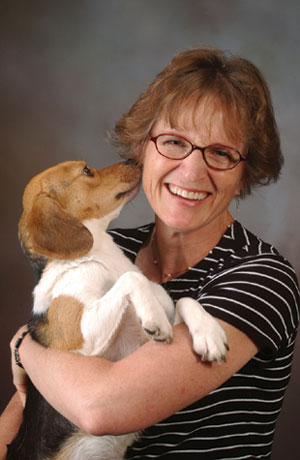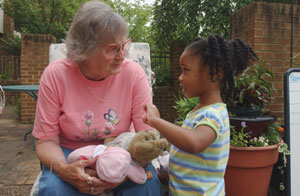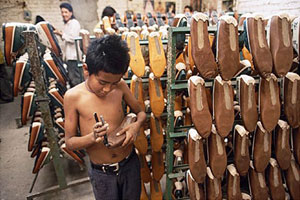Browsing the morning newspaper, you come across a story that cites a Virginia Tech professor involved in an unusual research project. "Huh," you think, "they do that at Tech?"
The university's vitality is fueled by a multitude of interesting studies being conducted in every corner of campus, and some of that research, at least in the public's eye, might seem a little, well, different. Here are a few of the many research projects going on at Virginia Tech that just might surprise you.
|
HOLISTIC MEDICINE GOES TO THE DOGS
|
 Marie Suthers-McCabe Marie Suthers-McCabe
|
In a distinctive case of East meeting Southwest, a new study at the Virginia-Maryland Regional College of Veterinary Medicine (VMRCVM) is investigating canine responses to a traditional Japanese form of alternative healing.
Marie Suthers-McCabe, director of Tech's Center for Animal Human Relationships, is assessing the efficacy of Reiki, an energy-based therapy, in relieving hip dysplasia pain in dogs. Though similar to acupuncture in that it focuses on the body's so-called "meridians," Reiki uses manipulation and massage instead of needles. "Basically, the Reiki master spends an hour with the dog doing quiet, hands-on energy work," Suthers-McCabe explains. "The therapy doesn't look like much to watch, but the dogs visibly relax."
Collaborating with Suthers-McCabe on the project are Peter Shires, a VMRCVM veterinary surgeon, and Ed Fox, a professor in Tech's computer science department and a certified Reiki practitioner.
Lest you think Reiki is some kind of passing fad, the National Center for Complementary and Alternative Medicine at the National Institutes of Health is sponsoring its own clinical trials to evaluate the ancient healing therapy.
|
|
And while the research may seem to depart significantly from modern science, the evaluations use such technology as a biomechanical force platform, software programs, and photocell sensors to measure the dogs' movement and pain levels.
Tech's study, funded by Desy Campbell, a Reiki master practitioner with a longtime interest in the VMRCVM, will wrap up at the end of the year. Suthers-McCabe says that if the therapy is deemed beneficial, "We could teach owners how to perform Reiki on their own dogs. This would be wonderful for dogs that are not surgical candidates or those not responding to medical treatment."
Now that's a vision that indeed buoys the spirit: a low-cost, drug-free alternative to treating a beloved pet's pain--all from the comfort of home.
|
|
IF AT FIRST YOU DON'T SUCCEED . . .
|
 Mechanical engineering graduate student Brett Leedy '04 and "Cliff,"
Mechanical engineering graduate student Brett Leedy '04 and "Cliff,"
an autonomous ground vehicle designed by a team of Tech students.
|
|
In March 2004, the Defense Advanced Research Projects Agency (DARPA), the research arm of the U.S. Department of Defense, offered $1 million to the first of 15 teams to finish its inaugural Grand Challenge, a field test for autonomous ground vehicles. Even though no vehicle traveled farther than about seven miles during the 2004 race, the agency is sponsoring a second competition this fall--and has ratcheted the prize to $2 million. Not surprisingly, Virginia Tech is once again a contender.
Why go to such lengths to discover new technology? Put simply, DARPA wants to develop unmanned vehicles that the military can deploy in dangerous situations. "The basic premise of robotics, including autonomous vehicles, is keeping people from having to perform dirty, dull, or dangerous jobs--the 'three Ds,'" explains Virginia Tech's team adviser Charles Reinholtz, Alumni Distinguished Professor of mechanical engineering.
For this year's competition, Tech has two teams competing among 40 and is one of only two entrants to qualify two vehicles, "Rocky" and "Cliff." The field of 40 will be cut to 20 during qualifying in late September through early October. To successfully compete in the Grand Challenge on Oct. 8, the remaining 20 autonomous vehicles will have to navigate a course of some 150 miles through the Mojave Desert--with no human intervention allowed past the starting line.
Reinholtz says that he and the team are ready for Tech's return trip to the challenge. "We gained experience with several new sensors and learned how to integrate these into an overall autonomous navigation strategy. Most importantly," he adds, "I think the students learned the difference between theory and practice."
As for the race itself, Reinholtz doubts that any team will actually finish the course, but he points out, "I don’t care so much about winning. My concern is about learning and improving. I look for commitment and effort--the will to excel. The students involved with the Grand Challenge have shown this in great measure. For me, there can be no greater reward."
|
|
MOM WAS WRONG--YOU CAN BE TOO CLEAN
|
In a surprising challenge to some age-old counsel, research undertaken by Assistant Professor of Civil and Environmental Engineering Peter Vikesland indicates that those highly popular products that get rid of bacteria may be harmful.
Many personal care products touted for their bacteria-fighting qualities--soaps, creams, lotions, cosmetics, and acne treatments among them--contain the synthetic antimicrobial agent triclosan, which is used to kill bacteria. Vikesland found that when triclosan reacts with chlorine in tap water, chloroform--classified by the Environmental Protection Agency (EPA) as a probable human carcinogen--is produced.
"This is the first work that we know of that suggests that consumer products, such as antimicrobial soap, can produce significant quantities of chloroform," Vikesland says. Some of the ways a person can be exposed to the agent, he adds, include "inhalation and skin exposure when using antimicrobial soaps to wash dishes or when taking a shower. There is also risk of exposure when using triclosan-laden moisturizers, as they may also react with water in the shower."
|

|
|
To its credit, the American Medical Association had already urged the Food and Drug Administration to closely monitor the home use of antimicrobials. The quick surge in popularity of antibacterial products, however, superceded any significant study of their possible harmful effects.
As a result of Vikesland's research, consumers around the world have begun to use more caution, and some stores in Europe and Asia actually pulled triclosan-based products off their shelves. But there's no need to panic. Vikesland indicates that more research is needed, particularly to establish what levels of exposure pose a threat.
|
|
LETTING SLEEPING BEARS LIE . . . FOR RESEARCH
|
 Colleen Olfenbuttel M.S. '05 and Ben Augustine '05
Colleen Olfenbuttel M.S. '05 and Ben Augustine '05
at the Virginia Bear Research Center in Blacksburg.
|
Can hibernating bears help with human health concerns? Wildlife professor Mike Vaughan, who studies bears at the Virginia Bear Research Center in Blacksburg, thinks so.
The bears at the center are considered "nuisance bears" that were captured by the Virginia Department of Game and Inland Fisheries and are kept for three to four months of hibernation, then re-released into the wild. In their dormancy, they become the perfect study-subjects for Vaughan and his students.
One study being conducted on the snoozing bears aims to learn more about human bone loss. "While denned, bears don't have much opportunity to exercise their muscles or bones," Vaughan notes.
|
Humans who are on bed rest don’t have that opportunity either, but the inactivity can lead to osteoporosis, which bears don't develop. In an effort to understand this difference and thus help humans, Vaughan draws blood from the bears and sends it to Seth Donahue, a biomedical engineer at Michigan Tech, who examines the blood hormones responsible for bone formation and breakdown.
"Donahue has found that even though bears do lose some bone material while denned, they also continue to make bone material," Vaughan reports. "And once out of the den, they make up any deficiency very quickly." The ongoing collaboration between the two universities, he adds, is pursuing how the bears manufacture the bone cells while on autopilot.
Potential for humans to benefit from the bear research exists in other ways, as well. One marvel of the mammals is that they don't eat, drink, or expel waste the entire time they are denned--which means, Vaughan notes, that "kidney function essentially stops; humans can't do that. If we could fully understand how bears recycle waste in their bodies without kidney function, it could have human health implications." Bears also store up on a significant amount of fat in the fall to sustain them through their hibernation, yet they don't experience the same cholesterol buildup as humans do. Needless to say, understanding why could be a boon.
For Vaughan, who has worked with bears for about 25 years, the possible applications of the bear research are fascinating. "When I first started working with bears, some of the human health implications were just coming to light; I had no idea at that time that bears could play such an important role in human health."
|
YOUNG AT HEART
|

A participant in Tech's Adult Day Services
interacting with a young friend.
|
Were you aware that Virginia Tech boasts the nation's only university-based shared-site intergenerational care program? Wait a minute. What's that--and why should you care?
Intergenerational programming--the structured interaction between older adults and children--is the purview of human development professor Shannon Jarrott, who believes that such relationships are vital. "As more adults live longer and require formal care services and as more children spend time in child-care settings, our generations are largely age segregated," she explains. "However, children and older adults can support each other's developmental needs. Children need to have trusting relationships with adults, and older adults need the opportunity to leave something of themselves behind."
|
| At Virginia Tech, fostering these relationships is facilitated by the university's
Adult Day Services (ADS) program and the
Child Development Center for Learning and Research, both of which are overseen by the Department of Human Development and are located in Wallace Hall. Here, the two generations provide cross-support for each other through "plans created with specific goals and objectives, such as cooperation or exercising motor skills or exercising creativity," Jarrott says. She cites a recent lesson to teach the children about fire. Their teachers made construction paper "fires" and planted them in the ADS rooms, then sent the children to "put them out" while the older adults supervised. For other activities together, the adults read to the children and help with lunch.
"Having the adults work closely with the children and tell them that their work is fantastic really supports the children's self-esteem. In turn, it supports the older adults; they often have had things taken away from them, such as their independence and their work, and it's good for them to be able to help a child," says Jarrott.
As a next step, Jarrott wants to capitalize on what she and her colleagues have learned. "We're interested in seeing healthy and active older adults get involved, too. I think they would have a lot to share, not just with younger children, but also with middle- and high-school students."
Because Virginia Tech has the only university-based shared-site intergenerational program, Jarrott adds, "We really are poised to be a model for the nation" by applying the benefits of the research. And the nation apparently agrees--Tech's program was selected to receive the Leadership Award for Outstanding Support of Intergenerational Programs from the sole national organization devoted to intergenerational programs, Generations United.
|
WHY DO CHILDREN WORK?
|
Management professor Larry French's research into child labor in developing areas has shown that understanding why children work isn't as simple as one might think--and that without understanding the reasons, there can be no lasting solution.
Gathering data from a case study in Franca, Brazil--the center of the country's shoe industry and a known employer of children and adolescents--French and fellow management professor Richard Wokutch found that children there work so they can buy the influx of goods marketed to them. "The diffusion of consumerist cultures to Brazil stimulates needs in children, while a production system ... enables them to evade legal prohibitions, obtain work, and earn money to meet those needs," French and Wokutch note in a paper outlining their research.
|

|
| The researchers also discovered that, surprisingly enough, child laborers aren't necessarily foregoing their education in order to work. Instead, when the school curriculum isn't especially challenging, children who work part-time jobs still do well in class.
And Father may not always know best, say French and Wokutch. Although it seems safe to assume that a family business would provide a safer environment for working children, the Franca study indicated otherwise. "Families routinely subject their child workers to toxic glues, pay them far less than warranted by their productivity, and discriminate against female children," the professors wrote.
French and Wokutch conclude that simply eradicating child labor from one industry will likely only send children to another industry that will allow them to work. Instead, the researchers assert that an integrated community approach that addresses the reasons children work is the only means to a permanent end to child labor.
|
HE KNOWS WHY THE WILD BIRD SINGS
|
|
|
Sometimes a major discovery begins with a simple "why?"
Assistant Professor of Biology Ignacio Moore wondered why birds sing at certain times and in certain places; after all, bird song, which lures potential mates, is vital to the species. That curiosity led Moore, along with biologist John C. Wingfield and psychologist Eliot A. Brenowitz at the University of Washington at Seattle, to discover that environmental cues might be the answer--a finding that could have far-reaching implications for humans.
The researchers found that bird song in the higher latitudes is triggered by seasonal changes; in other words, the length of a day causes changes in the song-control nuclei of a bird's brain. In the tropics, however, where seasonal changes are limited and days are approximately the same length year-round, Moore and his colleagues observed that bird song is driven by other factors.
|
|
Focusing on the same species of bird living in two completely different climates only 25 kilometers apart in the Andes Mountains, the researchers discovered that in the absence of seasonal changes, the birds in the tropical zone respond to "diverse environmental cues" that evoke reproductive physiology and behavior. In turn, Moore believes that because the environment impacts the lives of these birds, global warming could, by altering the weather, affect the brain functions of tropical birds and cause problems with the timing of their mating patterns.
Could this also be a long-term indicator of the reality of global warming? Moore plans to find out. The next step of his research is to determine the exact environmental cues that birds respond to, which he believes could be the amount of rainfall, the temperature, the availability of food, or a mixture of all three.
And finding the answer is only another "why?" away.
|
TALKING TURKEY
|
When talk of environmental waste comes up, most people's thoughts don’t immediately turn to turkey. But Curtis Novak, a professor of animal and poultry sciences, isn't most people.
Novak's latest research project zeroes in on turkey feed--specifically if changing its ingredients can benefit the environment. Here's why. To help boost the birds' size, turkey farmers routinely supplement the feed with such inorganic minerals as zinc, copper, and manganese. Because the minerals are not entirely absorbed during digestion, the turkeys' waste passes these elements into the environment.
"Currently, the big push in turkey feed is to use inorganic materials because they don't cost much," Novak says. "But [farmers] are probably using more than they need to. I think it could be cheaper to supplement with organic minerals if the amount used is reduced."
|
Associate Professor Shelly Nickols-Richardson; undergraduate Steve Moritz; and research specialist Curt Porterfield prepare a turkey for a body scan.
|
|
The key to Novak's theory is that organic minerals--which are trace minerals linked to an amino acid—are absorbed differently. "Organics are protected, in a way, by the amino acids, so they reach the level in the gut where they can be absorbed. Hopefully, they'll maintain performance but with less passed out in the manure."
To determine if the desired output--large, healthy turkeys--can be maintained by supplementing feed with organic minerals, Novak is employing the same technology to measure the birds' bone density that would be used for humans: a dual-energy X-ray machine that performs a body scan. "I don't think anyone’s ever used this on a turkey before," he admits. By scanning a bird's entire body, Novak can view its fat mass, bone mass, and lean body mass.
With financial assistance from the Virginia Poultry Growers Cooperative and Alltech, Novak plans to issue his findings by the end of the year. And he's optimistic, not only in regard to the research, but also about its potential applications. "This topic isn't on the EPA's radar yet, but with the levels of turkey waste we're producing in Virginia, I think it will be in the future. This could really help."
|
|
THINGS THAT GO BUMP IN THE NIGHT
|
|
 It's not uncommon for sleeping children to wake up crying because they have been frightened; studies show that about 75 percent of children between 4 and 12 years of age are afraid of something. In 5 to 10 percent of children, however, some fears are so severe that they will become full-blown phobias. And it's these children who most interest University Distinguished Professor of Psychology Tom Ollendick. It's not uncommon for sleeping children to wake up crying because they have been frightened; studies show that about 75 percent of children between 4 and 12 years of age are afraid of something. In 5 to 10 percent of children, however, some fears are so severe that they will become full-blown phobias. And it's these children who most interest University Distinguished Professor of Psychology Tom Ollendick.
Ollendick specializes in helping children overcome a specific phobia--an extreme, persistent fear that stems from an actual or anticipated encounter with a particular object or situation--and has successfully employed a battery of interventions over the years.
One such intervention is to systematically desensitize a child to the phobia by pairing the feared object or situation with a response that is not fearful, such as guided relaxation or playing games. Another component of desensitizing a child to a particular fear is to gradually expose him or her to aspects of it. For instance, if a child is terrified of dogs, Ollendick might progressively have the child look at a picture of a dog, view a dog through a window, step outside to look at a dog, and then eventually pet the dog.
Currently, Ollendick and other researchers are completing a National Institutes of Mental Health-funded project jointly conducted in Blacksburg and Stockholm, Sweden, to examine the effectiveness of a cognitive-behavioral treatment for specific phobias in children and adolescents between 7 and 16 years of age. The team--which includes several doctoral students in clinical psychology at Virginia Tech--plans to distribute its findings to other mental health professionals.
"Phobias result in considerable distress for children and their families," Ollendick says. "For example, children fearful of dogs or bees cannot go outside to play. Other children are homebound because of fear of the dark or thunderstorms."
Understandably, Ollendick finds his work gratifying. Any opportunity to improve a child's life must be, one imagines, the most satisfying outcome of this sort of research.
|
|